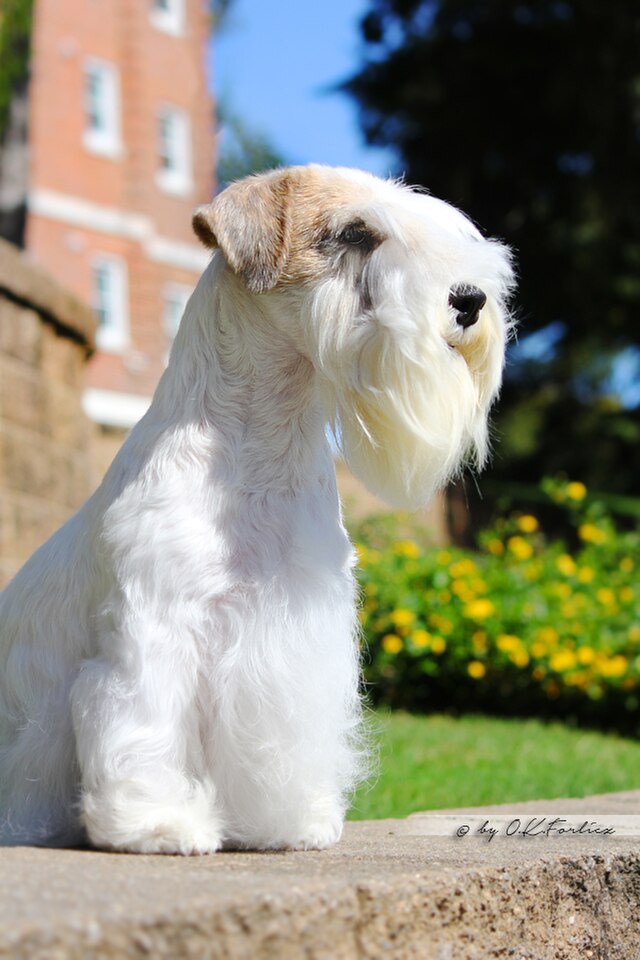


The Sealyham Terrier is a small, sturdy dog breed originally bred for hunting and rodent control. Known for its distinct appearance, the Sealyham Terrier has a wiry coat, large expressive eyes, and a strong, confident demeanor. Despite its small size, this breed has a fearless and spirited personality, making it a great companion for active families or individuals. They are affectionate with their owners and can be friendly toward strangers when properly socialized. While they have a strong prey drive due to their history as hunters, they also enjoy spending time with their family and thrive in an active environment.
The Sealyham Terrier was developed in the mid-19th century in Wales by Captain John Edwards, who wanted to create a dog that was capable of hunting small game like otters, foxes, and badgers. The breed is believed to have descended from several terrier breeds, including the West Highland White Terrier, the Dandie Dinmont Terrier, and possibly the Welsh Corgi. Originally used for hunting and pest control, the Sealyham Terrier became popular among British aristocracy due to its hunting prowess and charming personality. The breed was first recognized by the Kennel Club (UK) in 1908 and later by the American Kennel Club (AKC). Though its numbers have dwindled in recent years, the Sealyham Terrier is still appreciated for its historical role as a working dog and its loving temperament as a family companion.
The Sealyham Terrier is a compact, muscular dog with a sturdy frame. They typically stand between 10 to 12 inches tall at the shoulder and weigh between 18 to 24 pounds. Their most distinctive feature is their wiry, dense coat, which is predominantly white with markings of lemon, tan, or badger (a mix of gray and black). The coat is rough in texture and requires regular grooming to prevent matting. They have a strong, broad head with a prominent beard and mustache, giving them a dignified appearance. Their eyes are dark and round, and their ears are small, V-shaped, and folded. Sealyhams have short legs but are agile, with a strong and active build that allows them to pursue small game with determination. Their tail is typically docked, carried high, and is often seen wagging enthusiastically when they're excited.
The Sealyham Terrier has a bold, confident, and sometimes feisty personality. Despite their small size, they are not intimidated easily and can be very independent-minded. They are affectionate and loyal to their families, and though they may be reserved around strangers, they tend to warm up once they feel comfortable. Sealyhams are intelligent and alert, with a natural curiosity and strong hunting instinct. While they may be calm and relaxed at home, they retain a strong prey drive and enjoy chasing small animals. They are also known for their high energy levels, making them playful and fun companions. However, they can be stubborn and require consistent, positive reinforcement during training. Overall, Sealyhams are a delightful mix of boldness, charm, and loyalty.
Despite their small size, Sealyham Terriers are an active breed that requires regular exercise to stay healthy and mentally stimulated. They enjoy outdoor activities such as walking, playing in the yard, and going on adventures with their family. A good daily walk, along with some time for free play, will keep a Sealyham Terrier happy. They have a strong prey drive due to their hunting background, so secure, fenced areas are essential to prevent them from chasing after small animals. While they are energetic, Sealyhams do not require as much exercise as larger breeds, making them suitable for apartment living as long as they are given plenty of opportunities to play and explore. Mental stimulation through games and puzzle toys is also important for this intelligent breed, as it helps keep them entertained and prevent boredom-related behavior problems.
The Sealyham Terrier is an intelligent breed, but they can be independent and sometimes stubborn, which can make training a bit challenging. Positive reinforcement methods, such as treats, praise, and play, work best with Sealyhams. They respond well to short, engaging training sessions and should be taught with patience and consistency. Early socialization is important to help them become well-adjusted adults. Exposing a Sealyham Terrier to a variety of people, animals, and environments from a young age will help them develop good manners and reduce the risk of fear-based behaviors. While they are generally good with their family, Sealyhams may be a bit aloof or reserved with strangers. Their strong prey drive also means they may not always get along with smaller pets or animals unless raised with them from an early age. Proper training and socialization can help mitigate any potential issues.
The Sealyham Terrier is generally a healthy breed, but like all dogs, they can be prone to certain health conditions. Some of the most common health issues in Sealyhams include hip dysplasia, cataracts, and progressive retinal atrophy (PRA), a condition that can lead to blindness. Regular veterinary check-ups and early detection of any health problems can help keep the dog healthy and prevent long-term complications. Grooming is an important part of caring for a Sealyham Terrier, as their wiry coat requires regular brushing and trimming to prevent matting. Sealyhams are prone to dental issues, so regular tooth brushing and dental check-ups are recommended. They also need their ears checked regularly to prevent infections due to the floppy nature of their ears. Overall, Sealyhams require consistent care and attention to maintain their health and well-being.
The average lifespan of a Sealyham Terrier is typically between 12 to 14 years. With proper care, including a balanced diet, regular exercise, and routine veterinary visits, Sealyhams can live a long and healthy life. Their lifespan is relatively typical for small breeds, and maintaining a healthy weight and preventing obesity is crucial to ensuring they live a full and active life. Regular check-ups and monitoring for any breed-specific health concerns can help improve their quality of life as they age.
© copyright Dog Compendium 2024 - 2025